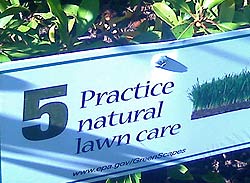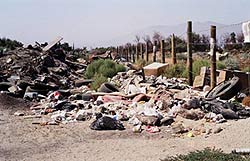About the author: Lina Younes has been working for EPA since 2002 and chairs EPA’s Multilingual Communications Task Force. Prior to joining EPA, she was the Washington bureau chief for two Puerto Rican newspapers and she has worked for several government agencies.
Lea la versión en español a continuación de esta entrada en inglés.
Some links exit EPA or have Spanish content. 
We’ve been living in our “new” house for nearly 14 years. With the normal wear and tear of daily living, we’ve made our share of repairs, plus we’ve purposely made some changes for energy and water saving purposes.
Several years ago, we bought all new major appliances with the Energy Star label. In our effort to reduce our carbon footprint, we took the pledge and changed all the lights to Energy Star light bulbs. (In the kitchen alone—we have 12!) That didn’t seem to be enough to cut the energy bill, so last summer, we changed all the windows at home to high performance Energy Star windows. The draftiness had been sealed. We did experience greater temperature stability in the home, yet those energy savings were not yet there. Forget about the rising electric bill costs, that was a whole other issue. So after some procrastination, we finally purchased a new air-conditioning/heating system with the Energy Star label AND the Energy Star programmable thermostat. Combined with our previous updates, that really made the difference! We are finally feeling at home and in our energy bills the long promised and awaiting benefits. Our energy consumption has dropped about 40 percent.
Having addressed the electric bill, we had to tackle another area—leaking toilets. Yes, I know it’s not an appealing subject, but, we have five toilets at home and three were leaking quite often. According to our stats, “a leaky toilet can waste 200 gallons of water per day”—you do the math. That’s a LOT of water wasted.
I learned about the WaterSense program through EPA and found out that the new toilets with the high-efficiency WaterSense label were finally available in the Maryland area where we live. We studied various options. We considered the dual flush toilets that we’ve seen in Europe and more recently in EPA’s Potomac Yard green building, but we finally opted for single flush toilets that use 1.28 gallons per flush and we couldn’t be happier. They do the job and we’ve put a stop to those leaky toilets, finally.
So, with the repairs in the home and greenscaping techniques in the garden, we’re trying to assume our green responsibilities starting at home
Haciendo reparaciones verdes
Sobre la autor: Lina M. F. Younes ha trabajado en la EPA desde el 2002 y está a cargo del Grupo de Trabajo sobre Comunicaciones Multilingües. Como periodista, dirigió la oficina en Washington de dos periódicos puertorriqueños y ha laborado en varias agencias gubernamentales.
Hemos estado viviendo en nuestra casa “nueva” por casi 14 años. Con el ir y venir del diario vivir, hemos tenido que hacer algunas reparaciones y nos hemos propuesto a hacer algunos cambios a fin de lograr ahorros de energía y agua.
Después de unos años, compramos todos nuestros principales enseres electrodomésticos con la etiqueta de Energy Star. En nuestro esfuerzo por reducir nuestra huella de carbono, asumimos la promesa—– y cambiamos todas las bombillas (o focos) a bombillas de la etiqueta Energy Star. ¡En la cocina nada más tengo 12!) Eso no fue suficiente para reducir la cuenta de electricidad y el verano pasado cambiamos todas las ventanas en la casa a ventanas de alto rendimiento Energy Star. Logramos reducir escapes de aire alrededor de las ventanas. También mejoramos grandemente la estabilidad en la temperatura en la casa, pero los anticipados ahorros todavía no habían sido realizados. (Dejemos aparte las cuentas de electricidad en alza, ese es un tema aparte.) Después de posponer la decisión, compramos finalmente un nuevo sistema de aire acondicionado y calefacción de Energy Star Y el termostato programable de Energy Star. ¡Combinado con las mejoras que habíamos hecho con anterioridad, por fin vimos la diferencia! Finalmente estamos sintiendo en la casa y en nuestras facturas de energía los beneficios prometidos y tan anticipados. Nuestro consumo energético ha bajado en un 40 por ciento.
Después de abordar el tema de la cuenta eléctrica, entonces abordamos otra reparación importante—los inodoros que estaban perdiendo agua. Sí, sé que no es un tema atrayente, pero, con cinco inodoros en la casa, y tres que estaban perdiendo agua frecuentemente, se imaginan. Según nuestros datos, “un inodoro con fugas puede desperdiciar 200 galones de agua al día, saque las cuentas. Esa es MUCHA agua desperdiciada.
Me enteré del programa WaterSense — mediante la EPA y encontré que los nuevos inodoros de la etiqueta de alto rendimiento WaterSense por fin estaban disponibles en el área de Maryland donde vivimos. Estudiamos varias opciones. Consideramos los inodoros de cadena dual que habíamos visto en Europa y recientemente en el edificio verde de EPA de Potomac Yard, pero finalmente optamos por un inodoro sencillo que utiliza 1.28 galones por tirada y estamos muy satisfechos. Están realizando su labor y por fin terminamos con los escapes de agua en los inodoros.
Por lo tanto, con las reparaciones y las técnicas de jardinería verde en el jardín estamos tratando de asumir nuestras responsabilidades hacia el medio ambiente empezando en nuestro hogar.

 These chores constituted a never-ending maintenance ritual that, though burdensome, I grudgingly acknowledged as necessary. And that is what I believed, until I saw this sign in our GreenScapes exhibit:
These chores constituted a never-ending maintenance ritual that, though burdensome, I grudgingly acknowledged as necessary. And that is what I believed, until I saw this sign in our GreenScapes exhibit: The Torres Martinez Reservation in southern California has historically been a magnet for illegal dumping. With rapid development in the area, large migrant worker population, and commercial agricultural operations, the open land of the reservation was seen as an easy place to dump illegally. The problem became so bad that operators on the reservation started collecting money to accept waste on their property, creating environmental and human health hazards from ill-managed and exposed dumps, which often caught on fire. The business school concept of “maximize profit and minimize cost” needed to change to “maximize human health and minimize harm to the environment”.
The Torres Martinez Reservation in southern California has historically been a magnet for illegal dumping. With rapid development in the area, large migrant worker population, and commercial agricultural operations, the open land of the reservation was seen as an easy place to dump illegally. The problem became so bad that operators on the reservation started collecting money to accept waste on their property, creating environmental and human health hazards from ill-managed and exposed dumps, which often caught on fire. The business school concept of “maximize profit and minimize cost” needed to change to “maximize human health and minimize harm to the environment”.